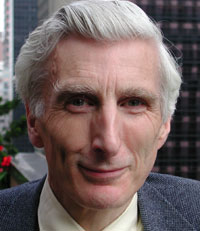The notion that if it comes to the worst in climate change we can fall back on geoengineering receives little credence in James Rodger Fleming’s new book Fixing the Sky: The Checkered History of Weather and Climate control. Fleming is a science historian and in the claims of some of today’s would-be climate engineers he sees a continuity with a long history of human attempts to control weather and climate. Most of the book traverses that history, which he urges we should understand and heed as we consider some of the proposed modern-day technological fixes to counter the effects of global warming.
He opens with the Greek myth of Phaeton who begged his father Helios to allow him to drive the chariot of the sun for one day but proved unable to hold the reins and keep to the middle course which Helios advised as safest and best. Only the intervention of Zeus with a fatal lightning bolt saved Earth from the consequent devouring flame. Fleming has something to say about the middle course when he gets to our own day, but in between he has many stories to tell in which hubris and ineptitude are combined, supported by “largely pathological” science, by opportunistic appeals to new technologies, and by “the false sense that macro-engineering will solve more problems than it creates”.
Rainmaking figures early and large in the book’s narrative. The first US government-employed meteorologist, James Espy (1795-1860), is well regarded in the history of science, but strayed from the scientific mainstream when promoting his idea that significant rains of commercial importance could be generated by cutting and burning vast tracts of forest. Fortunately his grandiose plans were not supported. Other scientific rain kings of the 19th century used a variety of explosive means, sometimes with public funding, with very uncertain results. Fleming describes them as altruistic monomaniacs with a vision of a prosperous and healthy world if precipitation could be controlled. Not charlatans, but sincere albeit deluded. However charlatans did appear on the scene, mixing secret chemicals, preying on misguided hope and gullibility, and the book devotes an entertaining chapter to them.
One of the ironic characters of the story as it carries into the 20th century is Irving Langmuir (1881-1957), Nobel Laureate in chemistry and associate director of research at General Electric. Fleming comments that, brilliant though Langmuir was in chemistry, his extensive work in weather control exemplified his own warnings about pathological possibilities of science gone awry. Langmuir argued in a 1953 seminar that science conducted at the limits of observation or measurement may become pathological if the participants make excessive claims for their results. Yet he himself made highly dubious and unsupported claims for the efficacy of cloud seeding on a large scale. His biographer comments that he simply “did not appreciate the complexity of meteorology as a science”.
Weather control has had particular interest for the military; their entry into the issue brings “a darkening mood”. The book covers a variety of involvements, from the need to disperse fog from British airfields during the conflicts of WW2 (involving a massive and successful use of fire) to the “sordid episode” of attempted rainmaking during the Vietnam war to try to impede the passage of North Vietnam soldiers along the Ho Chi Minh Trail. A UN Convention now prohibits military environmental modification techniques, though only if the effects are “widespread, long-lasting and severe”, a qualification insisted on by the US.
“Promethean possibilities” of climate tinkering using digital computing, satellite remote sensing, and nuclear power were part of the mid-20th century consideration of the subject. The scope of some of the dreams is startling – mega-construction projects to free the Arctic Ocean of ice or to lower the Mediterranean Sea, climate engineering to control weather vagaries. Fleming describes many of them, and the seriousness with which some were taken, recording with some relief the words of Harry Wexler, chief of scientific services at the US Weather Bureau. Wexler was interested in purposeful intervention, but warned that it contained “the inherent risk of irremediable harm to our planet of side-effects counterbalancing the possible short-term benefits”.
Against the background of his “long and chequered history of weather and climate control populated by a colourful cast of dreamers and losers” Fleming moves to a consideration of the geoengineering proposals of today. Not surprisingly he views them with a jaundiced eye. He doesn’t deny the seriousness of human-caused climate change, but he sees little to recommend the various climate engineering schemes put forward. Indeed they are jointly characterised as “largely fantastic”.
None escape that characterisation. Aerosols, arrays of reflective material in space, iron fertilisation of the ocean, are readily swept aside. But it was a little surprising to see carbon capture and sequestration (CCS) and biochar similarly treated. Admittedly there is much uncertainty surrounding CCS and it is more talked of than practised. It may indeed turn out to be impracticable, but it seems a little premature to condemn it as a possibility. Biochar as a form of sequestration he claims would mark the end of composting and would generate a massive amount of the known carcinogen benzoapyrene. I don’t know about the carcinogen, but I fail to see where the end of composting is involved. Klaus Lackner’s artificial trees are discussed in some detail and described as untenable.
Fleming advocates the “middle course” in dealing with climate change. That means reduction in the emission of greenhouse gases and adaptation to the measure of changing climate that we can no longer avoid. The risks associated with moving into geoengineering measures are too great. To those who ask if that risk is worse than the risk of global warming he replies that it just might be, “especially if we neglect the historical precedents and cultural implications”. However he speaks approvingly of colleagues who support middle course solutions but also advocate responsible geoengineering research, so presumably his rejection is not as total as it sometimes seems. That was reassuring because as a reader I sometimes wondered whether he was fully cognisant of the magnitude of the threat from global warming.
However we surely need to be cautioned against those who rush to the grand fixes. Fleming is right to strongly reject economist William Nordhaus’s conclusion that “geoengineering produces major benefits whereas emissions stabilisation and climate stabilisation are projected to be worse than inaction”. He also does well to remind us of the inadequacy of “back-of-the-envelope” calculations to support geoengineering proposals. And to point to the fact that those who understand the climate system best are most humbled by its complexity and are among the least likely to claim that they have simple, safe, or cheap ways to fix it.
His book is often fascinating reading. Its comedic treatment of the history which comprises most of its content is nuanced and satisfyingly complex. What initially struck me as a lighthearted survey turned rapidly into a rewarding engagement with a gallery of characters, many of them intelligent and able, whose mistakes and failings we may learn from and hopefully not replicate.
[Buy at Fishpond (NZ), Amazon.com, Book Depository (UK, free shipping worldwide).]


 A detailed investigation into the genesis of the 2006 Wegman Report — much beloved of climate sceptics because it was critical of the “
A detailed investigation into the genesis of the 2006 Wegman Report — much beloved of climate sceptics because it was critical of the “